Photos: Kip Miller
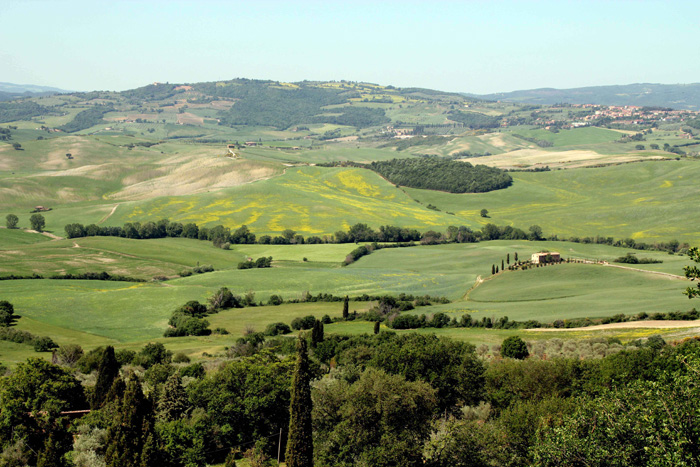
Tuscany is renowned for gently rolling hills dotted with cypresses, endless vineyards, and remarkable hills towns.
The allure of Tuscany is centuries old. During the Renaissance, it was
a frequent getaway for the wealthy Medici family. Today the region has
catapulted in popularity, ranking as the undisputed gourmand's Italy,
where award-winning Chianti and Brunello de Montalcino wines complement
tangy pecorino cheese, where bruschetta is drenched in exquisite green
olive oil and hand-made pappardelle is the king of pasta. As one would
expect, its world-famous cuisine is simply an affirmation of its bounty.
With Tuscany's reputation in mind, we head out of Florence in a southerly direction after three days of admiring its art treasures. Our tour guide Lisa, an enthusiastic English woman who has lived in a small coastal town to the north for many years, is already previewing our adventures to come. The bus zooms past a large cemetery where fallen American soldiers are buried on a 70-acre site. "More than 4,000 souls who gave their lives in World War II are buried here," says Lisa, pointing to curving fields of crosses framed by woodlands. "But our own Italian soldiers are buried in niches on walls surrounded by cypresses," she clarifies. "After 25 years their bones are removed to ossuaries. In Italy only the very wealthy have actual graves in the ground."
Within minutes we are surrounded by an undulating sea of green. "We have entered Chianti territory," Lisa announces. "It is the embodiment of the winemaker's Italy and also ranks as the number one retirement capital of the world. Here you will find many villas dating from the Renaissance that have been transformed by celebrities into opulent country homes." Rows of vines climb the hillsides, disappearing into the horizon. "Those are the famous Antinori Vineyards," says Lisa, motioning to the left. "They have been making award-winning Chianti wines based on Sangiovese grapes for six centuries." In the distance lies Arezzo, a densely wooded region famous for its parks and animal life. "This area is known for its unique medieval traditions," she divulges. "Here snakes and witches play an important part in the daily lives of its people and saint day processions have remained unchanged for hundreds of years."
We pass by
Monterigione, a fortified village mentioned in Dante's "The Divine
Comedy." Long ago visitors heading south would stop to honor the
many ancient martyrs who are buried here. Nearby on a sandstone hill,
San Gimignano's 14 towers spike pencil-like above the rest of the town.
"We won't have time to stop," comments Lisa. "But you can
get a sense of this town from afar. It is a UNESCO World Heritage site.
In centuries past, it was part of the itinerary of pilgrims on the Via
Francigena bound for St. Peter's in Rome." Today San Gimignano is
crowded with tourists who come to gape at its sky-high towers, soak in
the medieval atmosphere of Piazza della Cisterna and sample its unique
white wine, Venaccia di San Gimignano. For me the town evokes the rugged
Mani Peninsula in Southern Greece, where similar stone towers served as
hideouts for local clans engaged in generations of violent vendettas.
The fierce Maniates utilized tiny tower windows as outlets for their rifles.
"I will bet the locals did the same here," I suggest to my husband.
On the road to Siena, I marvel at the prosperity of the region. Every
inch of land is meticulously maintained. "Tuscany is known for its
efficient government," explains Lisa. "The wealth of the region
insures that there are good roads, schools, hospitals and abundant social
services." In addition to its world-famous agricultural products,
Tuscany also has many natural resources, notably marble and copper. "No
wonder so many foreign tourists choose to have getaway homes here,"
I comment to Kathy and Eric, our traveling companions. I sit back, envisioning
a bevy of plein air painters propping up their easels amid roadside poppies
and capturing the scenery on their canvases.
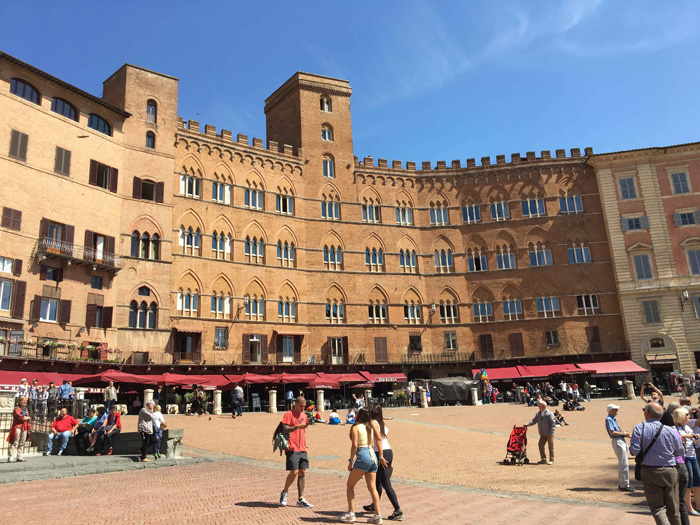
Siena's fan-shaped central Campo is surrounded by ochre-hued Renaissance buildings. It is the site of the annual Palio, a centuries-old horserace where competing neighborhoods (contrade) vie for the winning banner.
"Siena was an arch rival of Florence," Lisa announces as we approach its ramparts. "The two cities were always trying to outdo each other, and Siena boasts one of the most beautiful cathedrals in Italy. But it is Il Palio, a centuries-old horserace honoring the Virgin Mary that is Siena's greatest claim to fame." Marcella, a knowledgeable local guide, is waiting for us next to one of the city gates. "I am delighted to see you in Siena," she says with a disarming smile. "It is one of Italy's best preserved and most popular small cities, with many magnificent buildings from the medieval and Renaissance periods." She dives into a lengthy description of the competing neighborhoods, or contrade, that participate in the Palio held each year in July and August: "Out of 17 contrade, only 10 are chosen to compete. Each contrada has its own parish church, mascot and color." It's our second visit to Siena. In October 1969 an extra Palio was staged to honor the landing on the moon. We happened to be in Florence at that time and made a special day trip to catch the festivities in action. The spectacle made quite an impression on us.
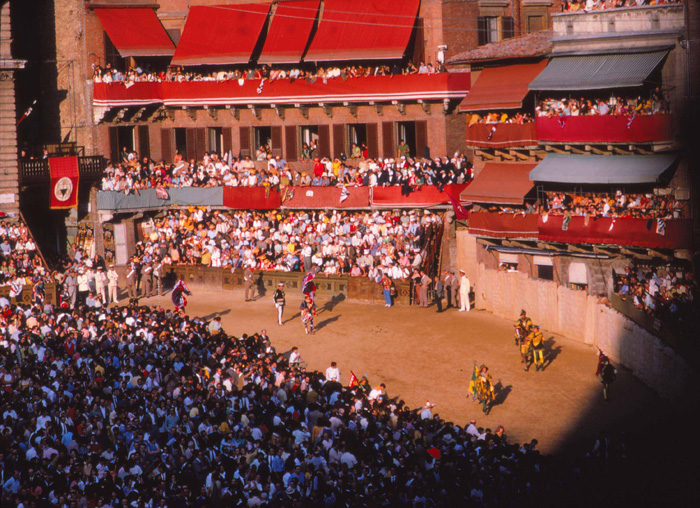
In October 1969, a day trip out of Florence to Siena brought us a special Palio honoring the American landing on the moon.
We wind through Siena's jumble of back streets lined with ochre-colored
palazzi, academies and shops, all descending to its central Campo, a huge
fan-shaped piazza dating from the 15th century. Here one finds the city's
main public buildings, including the Palazzo Pubblico, built during the
Renaissance complete with a distinctive 320-foot tower. "It is 12
feet taller than the tower of the Palazzo Vecchio in Florence," Marcella
notes. "Our two cities were arch rivals as you have heard."
I am totally taken in by Siena's historical integrity. It's as if it has
been plucked right out of the pages of history for our enjoyment today.
"When the Palio takes place in the summer, dirt is brought in to
cover the brick pavement to make it safer for the horses and riders,"
Marcella explains. "The jockeys ride bareback, banners are unfurled,
drums resound, and the whole Campo is filled with thousands of cheering
people who watch from bleacher stands and windows of surrounding buildings."
The build up to the Palio takes weeks, but the race lasts only a minute
and a half. "There are no rules," Marcella clarifies, "and
it is over before you know it." Apparently after the race, the lucky
contrada packs into Siena's Duomo to receive the winning banner, with
the heroic jockey hoisted high up in the air.
"Take some time to explore the town," says Lisa, making some recommendations for shopping and lunch. "We'll reconvene here in front of the Gaia Fountain in two hours." The four of us meander down a shopping street, passing by Nannini, Siena's renowned bakery. It is jam-packed with locals and tourists feasting on small sandwiches, salads and pastries. A corner display of Nannini's specialties is stacked with packages of panforte, a spicy holiday cake dense with fruit and nuts, flaky almond ricciarelli cookies and other traditional sweets. We load up with our holiday list in mind. "Follow me," motions Eric, leading us to a lunch spot he discovered on a quiet lane. Guido's is an elegant restaurant, its brick walls hung with photos of local and guest celebrities enjoying its signature dishes. The menu exemplifies Siena's culinary sophistication. We settle on asparagus tarts with truffle shavings, aromatic risotto flecked with pigeon, and squid sautéed with artichokes -- especially good choices accompanied by a crisp white wine.
"Our
famous Duomo is called the wedding cake," says Marcella, waving her
arms in front of Siena's unique zebra-striped cathedral dedicated to the
Assumption of Mary. "Take a look at those sculptures and decorations!"
marvels Kathy, awed by the jumble of French Gothic and Tuscan Romanesque
statuary adorning the façade. "For sure the Sienese were trying
to outdo the Florentines!" "Here you can see the coronation
of Mary," Marcella explains, "as well as the birth of Jesus
and several Old Testament characters. For some reason, Plato is among
them." The Duomo is a harmonious blend of black and white, the symbolic
colors of Siena. But it is the Duomo's interior that elevates it above
all others. Magnificent inlaid marble mosaic floors cover its entirety,
with contributions from about 40 artists depicting scenes from classical
mythology, the Old Testament, the allegories and virtues. "The floors
look very fresh to me," I remark to Marcella. "We cover the
floors for most of the year to protect them," she explains as we
stare at a panel of "The She-Wolf of Siena" dating from 1372.
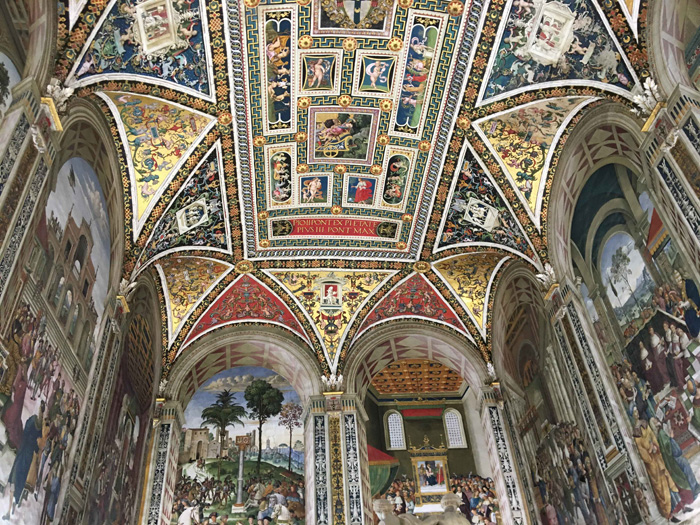
The Piccolomini Library inside Siena's magnificent Duomo is covered with vivid frescoes by Pinturrichio, a protégé of Raphael.
The cathedral is also brimming with priceless art, featuring works by
Donatello, Bernini and early sculptures by Michelangelo. We follow Marcella
into the Piccolomini Library where illuminated books of Gregorian chants
are upstaged by vivid frescoes by Pinturricchio, whose style resembles
Raphael. The frescoes tell the story of an uncle of a prominent Sienese
family who eventually became Pope Pius II. "Take a look at that ceiling!"
my husband whispers, pointing his camera at a mythological scene. "Too
bad we can't spend more time in here," says Eric, eying the long
line behind us. Marcella stops next to a fresco where Pinturrichio has
pictured himself next to Raphael. "The entire cycle was painted from
1502 to 1507. Aren't the details and colors amazing?"
Included in Tuscany's agricultural riches are olive groves that yield flavorful oil known as "green gold." Some of the very best is produced in the Chiana Valley surrounding Cortona, commanding high prices on the world market. As we journey south toward this popular town, we are encircled by ancient groves. "In my own village olive trees are considered members of the family," says Lisa. "We pamper them the year around. In winter they are very green and face the sky to receive some warmth. By summer they turn silvery to reflect the heat. Some of the trees here in Tuscany go back nearly 1500 years." She launches into a lengthy explanation of how olives are harvested in November and how she must maintain a good relationship with the village mill owner who presses the olives. I suddenly remember a quote by Thomas Jefferson: "The olive trees are the richest gift of heaven..."
Cortona is
encircled by massive Etruscan and Roman walls atop a 2,000-foot hill.
It is a pedestrian town and visitors must enter on foot through several
ancient gates. "There are many legends about its founding,"
says Lisa as we begin to climb. "Some say Noah arrived here after
the flood, and that his descendant, Crano, taking advantage of its strategic
location and breathtaking setting, built the town 273 years later."
It became an Etruscan stronghold, amassing great wealth through salt trade,
and later the Roman colony of Corito. "You can see many remnants
from those eras in its world-famous Etruscan Museum," she adds. Cortona
came under the control of the powerful Medicis in the 15th century who
built a massive military fortress, Girifalco, remodeling the original
Etruscan fortifications atop the town. "But truth be told,"
Lisa admits, "the whole world knows about Cortona because of Frances
Mayes's book, 'Under the Tuscan Sun,' followed by the movie that came
out in 2003." Frances bought and lovingly restored Bramasole, an
abandoned villa, and waves of tourists have been coming to Cortona ever
since.
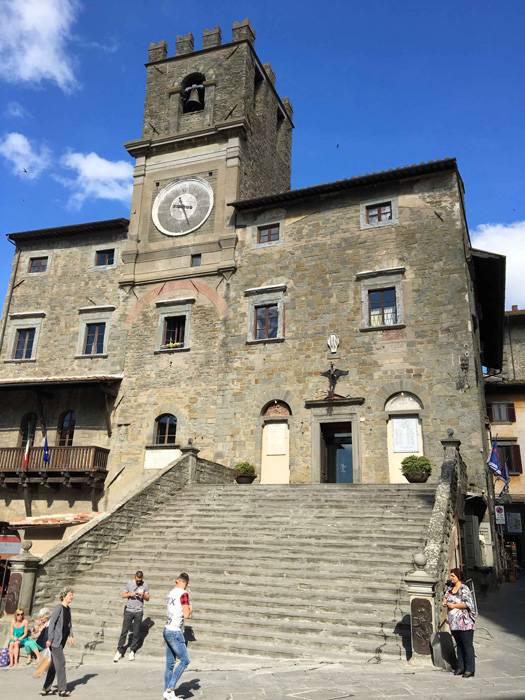
Cortona's 14th century Town Hall is a popular spot for weddings and official gatherings.
We descend on foot from Porta Montanina to the central piazza, once the
intersection of the Roman Cardo and Decumanus. Here stands Cortona's most
photographed building, a quaint 14th century town hall with a broad staircase
and clock tower. The piazza is a happening place encircled by crowded
restaurants and cafes. It is a town to be savored on foot and I look forward
to having extra time to explore its nooks and alleys. Lisa leads us through
Via Nazionale, also known as Roga Piano, crammed with attractive shops,
bars and small eateries, the only flat street in town and popular with
locals for their evening passegiata. Geranium pots adorn many storefronts
and the scent of pizza wafts from wood-burning ovens. In no time we arrive
at Piazza Garibaldi, overlooking a broad sweep of the Val di Chiana with
Lake Trasimeno in the distance. Our hotel is just steps away, a rather
spartan establishment, but compensated by its breathtaking views. We head
out immediately on our own passegiata, past attractive boutiques selling
linens, leather goods, ceramics, designer clothing, artisanal foods and
wines. Later our entire group gathers for a multi-course dinner at La
Grotta, a cozy Tuscan restaurant hidden in an alcove near the Town Hall.
The lineup of dishes become a blur by meal's end, but I can still taste
their tangy pecorino flan served warm, the house-made tortellini swirled
with ricotta and pesto, and a Tuscan sponge cake infused with chocolate
cream! Practically in a food coma, we stagger back to our hotel.
"Some
claim that Cortona is the grandmother of Troy and mother of Rome,"
says Alberta Blanchi, an expert local guide who is leading our morning
tour of Cortona. We are standing by the statue of Garibaldi at the foot
of Via Nazionale, eyes fixated on Val di Chiana's rich farmlands and villages.
Centuries ago this lush fertile valley was swampy and malarial, but through
hard labor it was transformed into one of Italy's most thriving agricultural
areas. We lag behind Alberta, stealing glances at narrow alleyways strung
with laundry as we head to Piazza Pubblico, where the City Hall is humming
with activity. "Lots of weddings take place here," brags Alberta,
"because wedding couples like to host their guests at any of several
excellent restaurants that are steps away." I spot two American couples
speaking Italian with confidence, undoubtedly part of the large expat
community here. "Cortona retains its history through layers of architecture,"
Alberta explains as we continue to Piazza Signorelli where a handsome
local theater dating from the neoclassical era doubles as the city multiplex.
The outer stone wall of the 13th century Palazzo Cazale catches my eye,
embellished with many coats of arms, a veritable primer on Cortona's noble
families. "Of course, the lion is the symbol of the Medicis,"
says Alberta. She leads us past a statue of Santa Margarita da Cortona,
a popular local saint, pointing out the town's Diocesan museum where two
prized Fran Angelico paintings are venerated. On the opposite side, Cortona's
small cathedral is famous for its Turkish-styled columns and capitals
inspired by Brunelleschi. "He's considered one of Italy's greatest
architects," she boasts.

Piazza Signorelli is enlivened by a neoclassic theater (right) that doubles as Cortona's cinema multiplex. The Etruscan Academy and Museum (left) houses one of the finest pre-Roman collections in Italy.
"Now let's head to the museum, also home of the famous Etruscan Academy," Alberta announces. Founded in 1727, it displays rare and unusual Etruscan and Roman artifacts found in the area, from hand-molded impasto vases to sarcophagi and urns for ashes. "The Etruscans had contacts with Greece and Egypt and were very much influenced by them," she explains. "They were concentrated in Etruria (Tuscany) and in the northern parts of Umbria where they were dominant from the 9th to the 1st century BC." We pause by a funerary bed with sculpted cushions depicting women in gestures of grief. They are so finely detailed that you can actually see their tears. Alberta heads to one of the museum's treasures, the Tabula Cortonensis, a bronze panel with Etruscan writing on two sides discovered in 1840 in Cortona. "It is about 2200 years old," she notes, "and it describes a legal transaction. The Etruscan alphabet added letters for sounds that did not exist in the Greek alphabet." We pause under a large bronze chandelier, clearly the museum's pièce de résistance. "It dates from the 4th century BC," explains Alberta, "and it has several circles of imagery, but please note the innermost one with a gorgon's head surrounded by snakes. You can see a reproduction in clay in the case behind that captures more of the details." The chandelier is so spectacular that it merits a room all to itself!
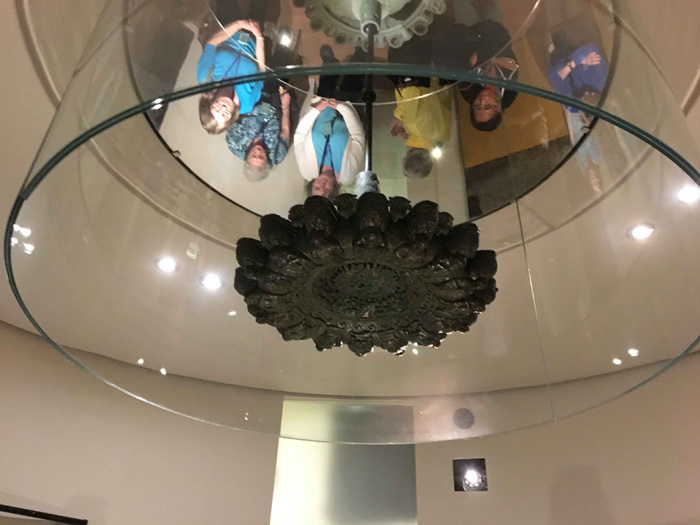
A bronze Etruscan chandelier is the jewel of the Academy collection, meriting a room all to itself.
My husband and I dedicate the afternoon to the alleyways and shops of Cortona while Kathy and Eric follow Lisa on a short hike to Villa Bramasole. "You will get a full report," Kathy promises as they depart. I am somewhat familiar with the story of Bramasole. Frances Mayes was a Georgia girl who taught creative writing at San Francisco State. When her 20-year marriage dissolved, she came to Cortona with her then boyfriend and was transfixed by Bramasole, an old farmhouse that had sat crumbling for at least a generation. She saw potential in its terraced lot planted with olive trees and grapevines, complete with stunning views of the surrounding countryside. Bramasole became a multi-year labor-of-love and Mayes had to employ local muratori (wall workers) to help restore the house. Water had to be brought in and there were many other challenges. The end result was a mélange of the old and the new, with Mayes utilizing original beams, floors and stonework wherever possible. For the movie with Diane Lane, another villa in the area was restored. When Mayes's book, "Under the Tuscan Sun," first came out, sleepy Cortona attracted thousands of Americans who were inspired to make their own journey of self-discovery. Today some maintain homes in town or the surrounding area. "Cortona is the Italian town that Americans call home," boasts a promotional brochure.
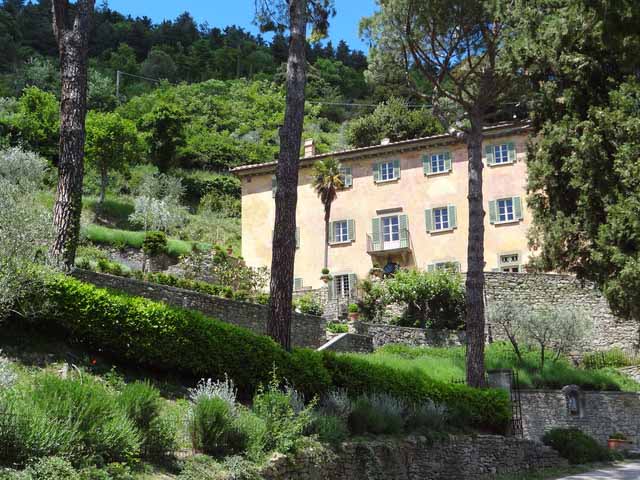
Frances Mayes' Bramasole, an abandoned villa she lovingly restored and memorialized in her book,
"Under the Tuscan Sun," attracts hordes of American tourists to Tuscany. Photo by Kathy Denardo.
The sun is sinking rapidly as our group commandeers two tables at La Loggetta,
a stylish restaurant with a covered loggia viewing the Town Hall. "Buona
sera, signori," two waiters chirp as they pass out a special menu.
It's another over-the-top Tuscan feast including a variety of antipasti,
appetizer tartlets, hand-made pici pasta with wild boar sauce, sliced
herbed turkey, and house-made pear gelato. A memorable red wine, La Calonica
Calcinaio Cortona, made from Sangiovese grapes with hints of berries,
complements the meal. "Such abbondanza! But we can't keep eating
like this," I whine as we leave, vowing to skip dinner tomorrow.
The Val d'Orcia is Tuscany's most photographed valley, renowned for velvety green hills, vineyards and rustic aziendas of burnished stone. We depart Cortona in the cool of morning, marveling at scenery virtually unchanged for centuries. "We're heading straight to Pienza," Lisa says excitedly. "It was built during the 15th century as the ideal Renaissance town." And since we are in prime wine country, she dives into a lengthy primer on Italian wines, noting that Italians are among the world's most dedicated aficionados: "According to Horace, no poet was ever a drinker of water, and wine making has been going on for thousands of years in the Val d'Orcia." Apparently, the clever Romans figured out how to store wine in barrels and how to seal bottles with corks. Later, during the Dark Ages, the art of winemaking almost vanished, relegated to monks sequestered in remote monasteries. "Today, winemaking has evolved into high art and Italy exports some eight million bottles of wine yearly," Lisa brags, "with about 350 recognized varieties."
Pienza is
completely enclosed in walls atop a hill, a city of utopian Renaissance
perfection. We approach it through a handsome gate, the Porta al Prato,
where a local guide, Anna, is all revved up to take us on a stroll through
its main street and important buildings. "This gate was destroyed
by the Germans during 1944," she notes, "but it was cleverly
restored in 1955 using a tempera wet plaster technique." Off to the
right, flower-filled Via Gozzante leads to a lookout with a sweeping view
across the valley, perhaps the most enchanting rural panorama I have seen
in my entire life. "Pienza owes its creation to Pope Pius II, who
loved his home town of Corsignano and wanted to transform it into a model
Renaissance town, idealized by architect Bernardo Rossellino, a protégé
of the great Renaissance maestro Leon Battista Alberti," Anna explains.
Apparently, Pius gave him a mandate to create a cathedral, a papal palace
where future Popes could holiday, and a town that would follow his esthetic
and moral principles. The buildings are a fusion of Renaissance and Gothic
styles, adorned with selected paintings from Siena. Some of the architectural
canons that went into Pienza's creation were later adhered to by Michelangelo
and others as they embarked on designing some of the country's most important
piazzas and buildings.

The Piccolimini Palazzo in Pienza, a utopian town built during the Renaissance, opens to a trapezoidal piazza distinguished by an unusual well with Corinthian columns.
"As one would expect, Pienza is a UNESCO World Heritage Site," Anna confirms. We enter the tiny church of San Francesco, built in the medieval era with thick walls and tiny windows, and then head to Piazza Pio II where a palazzo on the west side was once the Pope's residence. Behind it an enclosed Renaissance garden spills out to the Orcia Valley. In the center is a late Gothic marbled cathedral. The piazza is trapezoidal, creating an optical illusion that makes it appear larger. The edge of the square is marked by an unusual well with delicate Corinthian columns. "Every September we hold a Bocce Ball Festival here," says Anna, suppressing a chuckle. "But we use wheels of pecorino cheese with hard black crusts instead of balls. You can stop at any of our cheese shops for tastes." We wander later on our own, discovering the tanginess of pecorino for ourselves, surveying Pienza's handicrafts and food products. Every inch of Pienza is upscale, its niche as an upmarket tourist destination a fitting extension of its utopian legacy. Our group heads to Dal Falco, a family-run restaurant on Piazza Dante Alighieri, where everything is made daily from scratch. Friendly waiters shower us with savory Tuscan prosciutto, assorted pecorino, grilled mushrooms, ravioli with butter and sage, and spaghetti tossed in a tangy sauce. Just when we think we're done, trays of biscotini materialize, to be dipped in sweet Vin Santo. I peruse the olive oil bottle on the table. It's labeled Fattoria Fregoli, extra virgin and hand-harvested, the product of a local agriturismo that is revered in the world of olive oil.

Pecorino, Pienza's world-famous artisanal cheese, comes in several varieties: fresco, semi fresco, stagionato and aromatizzado.
"In Italy we always sing after a big meal," chortles Lisa as
we board,
handing out lyrics for a popular song,"'Sono Italiano" (I am
an Italian). Thankfully, just as our ears beg for silence, the bus pulls
into the parking lot at Altesino Winery for an afternoon tasting. "The
owner has four wineries and 44 hectares of land," staff member Ilaria
explains as she introduces the tour. "Here in Altesino's fermentation
cellar we start with machines that extract the stems, crush the grapes
and transfer them into tanks. After 20 days, the solids are removed and
liquid is poured into oak barrels for aging. Our oak is Slovenian. It's
a wonderful wood that creates amazing wine." She points to a gadget
on top of a barrel: "This is an air lock device that was invented
by Leonardo da Vinci to filter out gas in wine." "How interesting!"
my husband breaks into a smile. We follow Ilaria to a tasting room overlooking
the Val d'Orcia. The first wine poured is Rosso di Montalcino, DOC, made
entirely of Sangiovese grapes. It rests for eight months in barrels and
one year in bottles. An inexpensive wine, it has a classic taste, with
overtones of strawberry and cherry. We sample their Super Tuscan IGT,
a blend of Merlot, Cabernet and Sangiovese. It is fuller-bodied, darker
and spicier, with a bit of tannin. We end with Brunello di Montalcino,
DOCG, made entirely of Sangiovese grapes. "This wine will be at its
peak after 10-15 years and goes well with meat, cheese and truffles,"
explains Ilaria. "Wow!" Eric interjects. "It's wonderful
and full-bodied, with a lingering taste!" "Exactly," Ilaria
nods. "As it ages, it will get even softer."
Back in Cortona for the evening, we blend into a crowd of locals taking their passegiata. I am surprised to see many pedigreed dogs accompanying their owners as they stroll. One well-fed bulldog is carrying a gnarled branch in his mouth, attracting scores of admirers. We embark on some last minute shopping, only to meet the dog again two hours later, still clinging to his branch. Food is out of the question, but in the glow of twilight, Ti Amo, a gelateria advertising authentic Tuscan flavors, is too alluring to pass up. The owner wants to close, yet she accommodates us with a smile, along with several other last minute customers. I pull up a chair and linger unashamedly over my mango gelato. "Dolce far niente!" she winks at me.
